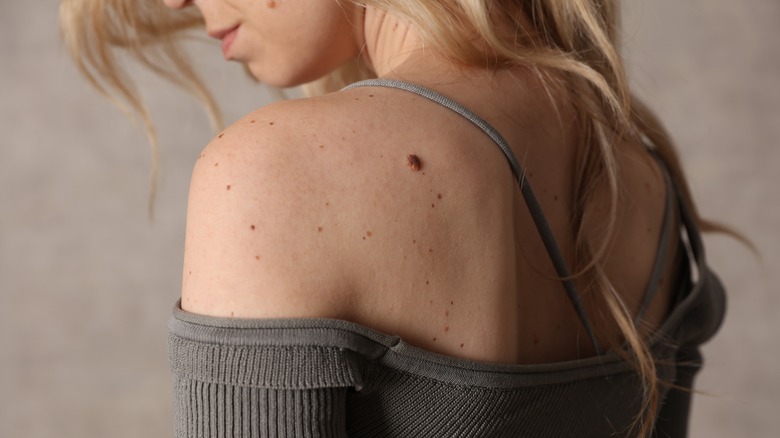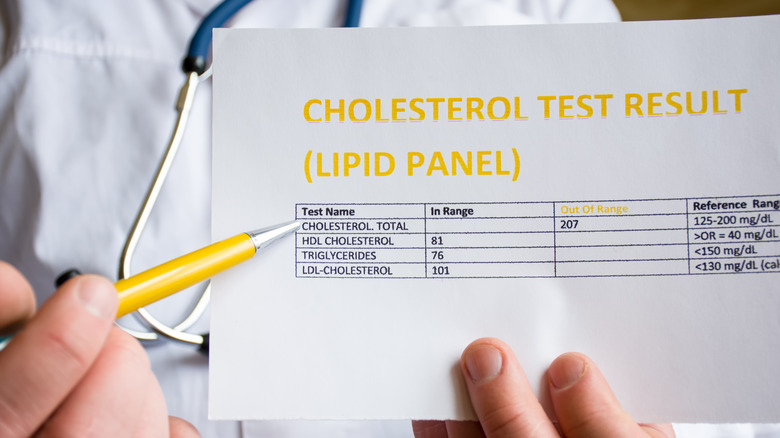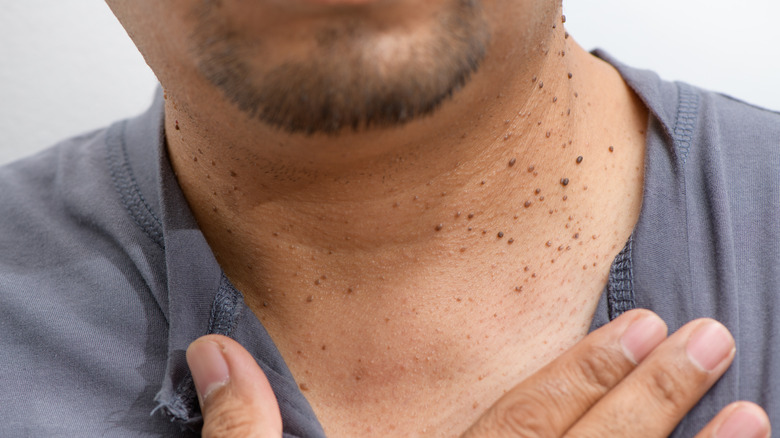Can High Cholesterol Cause Skin Tags? Here's What We Know
Skin tags (medical name: acrochordons) are flesh-colored (or sometimes darker) and harmless growths that mostly appear in these areas of your skin — eyelids, armpits, neck, groin area, upper chest, and under your breasts. Although they don't pose a threat to your health, they can get caught in clothing and be bothersome. While experts don't know for sure what causes these benign tags, some have linked the constant rubbing together of skin in these areas as a possible cause, although this is not a widely accepted viewpoint.
Among experts who discuss more root causes of skin tags, some of the most talked about health conditions are insulin resistance and diabetes. But, these are not the only underlying causes of skin tags. High cholesterol could be a culprit too, but in a more indirect way. According to a 2019 study published in the Indian Dermatology Online Journal, there is an association between metabolic syndrome and skin tags. Dyslipidemia, also known as high cholesterol or hyperlipidemia, is one of the health conditions that make up the cluster that is metabolic syndrome.
How are metabolic syndrome, high cholesterol, and skin tags related exactly? Let's take a closer look.
Metabolic syndrome, high cholesterol, and skin tags: The connection
As explained by general practitioner specializing in dermatology, Dr. Finbar McGrady, via YouTube, metabolic syndrome is like the perfect storm that wreaks havoc on your body. Abdominal obesity, elevated levels of triglycerides, low levels of "good" cholesterol or high-density lipoproteins (HDLs), high blood pressure, and elevated levels of fasting blood sugar coming together in metabolic syndrome can manifest on your skin via skin tags, per the expert.
It is also important to know that your cholesterol levels mean more than you think. Hyperlipidemia refers to having a high level of triglycerides and low-density lipoproteins (LDL) or "bad" cholesterol in your blood.
While there is no scientific data to point toward a direct link between high cholesterol and skin tags specifically, the concern here is with metabolic syndrome. In fact, a 2024 study published in Pediatric Dermatology even linked skin tags with metabolic syndrome in children under the age of 18. So, preventing skin tags is oftentimes going to be a matter of preventing metabolic syndrome.
Preventing skin tags: What can you do
First and foremost, you may need to be tested by your dermatologist to confirm that what you're dealing with are, in fact, skin tags. There are several other skin conditions that you could be mistaking for skin tags, such as moles, keloids, and dermoid cysts. Maintaining a healthy weight, exercising, and eating well (limiting processed food and increasing your intake of whole grains, fruits and vegetables, lean proteins, and healthy fats), can go a long way when it comes to combating metabolic syndrome, and therefore, skin tags. Limiting alcohol consumption and quitting smoking can help too, per Dr. Finbar McGrady via YouTube.
While genetics are thought to play a role in the development of skin tags, maintaining an overall healthy lifestyle could prevent their formation too. Maintaining good cholesterol levels is just one piece of this puzzle. If you're interested about how else high cholesterol could show up on your skin, you might be interested in reading about what your skin can tell you about your cholesterol.
While you don't necessarily have to get rid of skin tags, they could become irritated and develop in areas that cause discomfort to you. In such instances, you can visit your dermatologist and look at options for removal, which include cryosurgery, electrodesiccation, or simply snipping them off.



